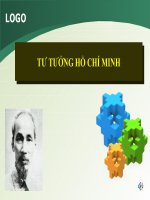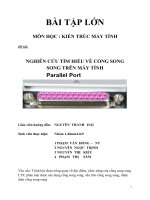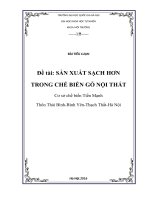09623 nhóm1 discussion2 intermkt (1)
Bạn đang xem bản rút gọn của tài liệu. Xem và tải ngay bản đầy đủ của tài liệu tại đây (358.1 KB, 9 trang )
INTERNATIONAL MARKETING
The list of members, assigned tasks and their completion status:
Name
Student ID
Completion
Lê Trần Hoàng Trâm
2121013200
100%
Lâm Ngọc Tường Vy
2121013345
100%
Nguyễn Hữu Lan Anh
2121013612
100%
Lê Thị Thanh Thúy
2121012798
100%
Vũ Thùy Bảo Trâm
2121012406
100%
1. Explain Asean free trade area, WTO, EVFTA
1.1. Asean free trade area:
The ASEAN Free Trade Area (AFTA) was established in January 1992 to eliminate
tariff barriers among the Southeast Asian countries with a view to integrating the
ASEAN economies into a single production base and creating a regional market of
500 million people.
Most of the Southeast Asian region is now a free trade area, the first six signatories of
the Common Effective Preferential Tariff scheme for the ASEAN Free Trade Area
namely Brunei, Indonesia, Malaysia, Philippines, Singapore and Thailand
(collectively referred to as ASEAN-6). Cambodia, Laos, Myanmar and Vietnam
(collectively referred to as CLMV) are required to join AFTA upon being admitted to
this block. It is currently one of the largest free trade areas in the world.
The Agreement on the Common Effective Preferential Tariff (CEPT) Scheme for the
ASEAN Free Trade Area requires that tariff rates levied on a wide range of products
traded within the region be reduced to no more than five percent. Quantitative
restrictions and other non-tariff barriers are to be eliminated.
The elimination of tariffs and non-tariff barriers among the ASEAN members has
served as a catalyst for greater efficiency in production and long-term
competitiveness. Moreover, the reduction of barriers to intraregional trade gives
ASEAN consumers a wider choice of better quality consumer products.
The free trade area covers all manufactured and agricultural products. However, 734
tariff lines in the General Exception List, representing about 1.09 percent of all tariff
lines in ASEAN, are permanently excluded from the free trade area for reasons of
national security, protection of human, animal or plant life and health, and of artistic,
historic and archaeological value.
1.2. WTO free trade area
The World Trade Organization (WTO) is the only global international organization
dealing with the rules of trade between nations — is the international organization
whose primary purpose is to open trade for the benefit of all. WTO is the only global
international organization dealing with the rules of trade between nations. At its
heart are the WTO agreements, negotiated and signed by the bulk of the world’s
trading nations and ratified in their parliaments.. The WTO (World Trade
Organization) has many Free Trade Areas (FTAs) established by member countries.
Here are some prominent WTO FTAs:
1. NAFTA: The North American Free Trade Agreement is an FTA between the United
States, Canada and Mexico, signed in 1994.
2. CAFTA-DR: The Central America Free Trade Agreement-Dominican Republic is
an FTA between the United States and Central American countries and the Caribbean
Community, signed in 2004.
3. EU-Korea FTA: Free Trade Agreement between the European Union and Korea,
signed in 2011.
4. TPP: The Trans-Pacific Partnership is an FTA between 12 countries, including
Australia, Brunei, Canada, Chile, Korea, Mexico, Japan, New Zealand, Peru,
Singapore, USA and Vietnam, signed in 2016.
5. CPTPP: The Comprehensive and Progressive Agreement for Trans-Pacific
Partnership is a new version of the TPP after the US withdrew from it, still includes
the remaining 11 countries and was signed. ends in 2018.
The WTO is run by its member governments. All major decisions are made by the
membership as a whole, either by ministers (who usually meet at least once every two
years) or by their ambassadors or delegates (who meet regularly in Geneva).
The WTO agreements are lengthy and complex because they are legal texts covering a
wide range of activities. But a number of simple, fundamental principles run
throughout all of these documents. These principles are the foundation of the
multilateral trading system.
+ Trade without discrimination
+ Freer trade: gradually, through negotiation
+ Predictability: through binding and transparency
+ Promoting fair competition
+ Encouraging development and economic reform
There are a number of ways of looking at the World Trade Organization. It is an
organization for trade opening. The goal is to help producers of goods and services,
exporters, and importers conduct their business. It is a forum for governments to
negotiate trade agreements. It is a place for them to settle trade disputes. It operates a
system of trade rules. Essentially, the WTO is a place where member governments try
to sort out the trade problems they face with each other.
1.3. EVFTA free trade
EU-Vietnam Free Trade Agreement (EVFTA) is a new generation FTA between
Vietnam and 27 European Union member states. EVFTA and Trans-Pacific
Partnership (TPP) are two of the largest new generation free trade agreements that
Vietnam's largest ever negotiated.
On December 1st, 2015, the negotiation rounds of EVFTA was officially announced
to be concluded, and its official full text was published on February 1st, 2016. On
June 26, 2018, EVFTA was split into two agreements, one is the Trade Agreement
(EVFTA), and the other is the Investment Protection Agreement (EVIPA); at the same
time officially ended the legal review process for the EVFTA Agreement. In August
2018, the legal review process for EVIPA was also completed.
The two Agreements were signed on June 30, 2019. On January 21, 2020, the
International Trade Committee of the European Parliament (INTA) approved the
Agreement, the European Parliament on February 12, 2020 officially approved both
agreements.
According to the European Commission, the agreements will provide opportunities to
increase trade and support jobs and growth on both sides, through
+ Eliminating 99% of all tariffs
+ Reducing regulatory barriers and overlapping red tape
+ Ensuring protection of geographical indications
+ Opening up services and public procurement markets
+ Making sure the agreed rules are enforceable
Key areas of commitment in EVFTA include: trade in goods, rules of origin, customs
and trade facilitation, the Sanitary and Phytosanitary measures (SPS), The Technical
Barriers to Trade (TBT),...
To sum up, the implementation of the EVFTA allows not only tariffs reduction, but
also removes regulatory barriers and eases all aspects of the import/export process.
2. List the opportunities and threats when Vietnam became a member of
Asean and WTO.
2.1. Opportunities and Threats of being a ASEAN’s member
2.1.1. Opportunities:
- Participate in all ASEAN activities
Vietnam has the opportunity to participate in all ASEAN activities in various fields
including economics, culture, education, and technology.
- Attract foreign direct investment
As a WTO member, Vietnam is allowed to use 10 percent of its investment capital to
develop the agricultural sector.
Joining the ASEAN Economic Community (AEC) and participating in free trade
agreements with ASEAN's partners have provided both opportunities for Vietnam to
attract foreign direct investment and serve as a bridge for Vietnam to access potential
markets within and outside the region.
The most anticipated opportunity, not only for Vietnam but for all ASEAN countries,
is investment and cooperation from large and developed economies. The connectivity
and establishment of a more unified and integrated ASEAN will make major investors
see ASEAN as a common playing field, a shared workshop where there is a unified
pool of resources, especially skilled labor at relatively lower costs. Attracting more
investment implies a faster and more active process of technology transfer.
- Expand the market
Having a larger market is another advantage of the AEC through the liberalization of
goods and services within the ASEAN region. This will encourage larger business
activities and investments in the region. Increased foreign direct investment and
economic activities in the region will naturally lead to an increase in insurance
demand in Southeast Asia. Vietnamese enterprises will invest more in production,
business, and service activities in other ASEAN countries. This presents a great
opportunity for Vietnamese businesses to seize the chance to expand their market.
What is more, Vietnam has constantly improved its status in the world. It was elected
a non-permanent member of the UN Security Council for a two-year term from 2008
to 2009. This year, as ASEAN chair, it represented the group at the recent G20 summit
in Toronto and last month, Ho Chi Minh city hosted the World Economic Forum on
East Asia.
- Expand exports and contributes to the growth of Vietnam's economy
The AEC helps to expand exports and contributes to the growth of Vietnam's
economy. ASEAN is currently Vietnam's leading and important trading partner, and it
serves as a driving force for maintaining the country's growth and exports.
With the formation of the AEC, Vietnamese businesses can sell their products to
ASEAN countries almost as easily as selling domestically. This is a significant
advantage for the movement of goods for businesses. Moreover, import-export
procedures will be streamlined, and the reform of rules of origin, aiming to allow
businesses to self-certify origin, will create favorable conditions for businesses to
facilitate the customs clearance of goods to ASEAN markets.
2.1.2. Threats:
- Compared to the original six ASEAN member countries
One of the biggest challenges for Vietnam when joining the AEC is the development
gap compared to the original six ASEAN member countries (ASEAN-6).
- The issue of low labor productivity
The second challenge for Vietnam is the issue of low labor productivity. According to
the International Labour Organization (ILO) report on labor productivity, Vietnam has
the lowest labor productivity among the Asia-Pacific APEC region. Compared to
other ASEAN countries, the average labor productivity of Vietnamese workers is less
than half of that in the Philippines, equivalent to 2 workers in Thailand, and only 5
workers in Malaysia. Furthermore, the productivity of one worker in Singapore is
equivalent to that of 15 workers in Vietnam.
- Challenge is the increasing competition
The third challenge is the increasing competition faced by Vietnamese businesses.
With the promotion of trade liberalization within the ASEAN Economic Community
(AEC), trade barriers and non-tariff barriers among member countries will gradually
be eliminated. Vietnamese export products will have to face competition from goods
produced by other countries in the ASEAN market. The formation of the AEC will
create a common market without trade barriers, services, and capital barriers, thereby
intensifying competition for Vietnamese businesses.
2.2. Opportunities and Threats of being a WTO’s member
Member countries utilize the WTO as a forum for the negotiation of trade agreements
and as the arbitrator of trade disputes. The WTO is often associated with the removal
of trade barriers. At the same time, the organization supports some such barriers, such
as those designed to protect consumers, prevent the spread of disease, to serve as
punishment for failing to follow WTO trade rules, or to assist developing markets. In
cases where barriers exist, the WTO encourages transparency and consistency.
Together, these forces increase predictability for outside businesses and investors.
2.2.1. Opportunities
- Can access to latest technological advances for national modernisation and
industrialisation, enjoy ensured equal access to all member country
markets
Vietnam joins the WTO to avoid being solitary in the business world. As a MFN
status country, it is in conformity with the current trend of international trade and
Vietnam’s interests of national construction and economic development.
Exports bring home capital to import advanced equipment and technologies and other
products of an intellectual-based economy. Being admitted to the WTO, the tariff
barriers will be removed or reduced, so as the quotas.
Products that Vietnam has advantages such as textiles and garments, footwear, coffee,
rubber, processed seafood, furniture, electronics appliances will have more
opportunities on the world market.
- Attract foreign investment:
Membership in the WTO has made Vietnam an attractive destination for foreign
investors, particularly those looking to take advantage of the country's low-cost labor
and favorable business environment.
- More transparent trade practices:
The WTO focuses on transparency. The WTO asks member states to set ceilings on
tariffs for specific goods. Admission to the WTO requires countries to adhere to
certain rules and regulations, which can help to improve transparency and reduce
corruption in international trade.
- Greater competitiveness:
Once tariff barriers are reduced for removed and quotas abolished, there’re many
opportunities for Vietnam to succeed in global marketplace
By joining the WTO, Vietnam has been forced to become more competitive in order to
succeed in the global marketplace. This has led to improvements in productivity,
efficiency, and innovation.
- Improved legal framework:
The WTO membership has encouraged Vietnam to develop stronger legal and
regulatory frameworks that are compatible with international standards, which can
help to attract more foreign investment and create a more stable and predictable
business environment.
2.2.2. Threats
- Integration but not dissolvent
Vietnam integrates but has to maintain national identity as well as the regime’s
identity, always following the policy of independence and self-reliance in economic
development.
- Competition are more severe
Once tariff barriers are reduced and quotas abolished, we have to be more competitive.
Products of low competitiveness can not be exported. On the other hand they will be
defeated by foreign products. Thus, domestic businesses might face bankruptcy and
the unemployment rate might rise.
- The difference in development level
The development gap between Vietnam and the other ASEAN-6 countries is evident
in various aspects such as the size of the economy's capital, the scale of enterprises,
the level of scientific and technical advancements, and labor skills. With the
implementation of ASEAN Community Points since 2015, Vietnamese businesses are
expected to encounter intensified competitive pressure from imported goods, products,
services, and investments of other ASEAN nations, particularly when non-tariff
barriers are lifted. This may lead to certain industries having to downsize production
or even cease operations altogether.
- Labor productivity
One of the challenges faced by Vietnam is its low labor productivity. The International
Labor Organization (ILO) report on labor productivity indicates that Vietnam has the
highest productivity in the Asia-Pacific Economic Cooperation (APEC) region.
However, compared to other countries in ASEAN, the average productivity of
Vietnamese workers is less than half of that of Philippine workers and only one-fifth
of Thai and Malaysian workers. In comparison, one worker in Singapore is as
productive as fifteen Vietnamese workers. Many people assume that low productivity
is advantageous because it is often linked to low wages. However, the reality is more
complex. Low salaries are only attractive when they are lower than the actual
productivity level, allowing employers to gain an advantage by paying lower wages.
Nevertheless, the cost of living in Vietnam has been steadily rising, causing wages to
increase at a faster rate than productivity. This trend has eroded the once significant
advantage of cheap labor in the region.
References
CƠ HỘI VÀ THÁCH THỨC CỦA VIỆT NAM KHI GIA NHẬP CỘNG ĐỒNG KINH
TẾ ASEAN. (n.d.). VNU. Retrieved June 16, 2023, from
/>0Tam.pdf
Cộng đồng Kinh tế ASEAN - Cơ hội và thách thức. (2021, August 11). Báo điện tử Đảng Cộng sản Việt Nam. Retrieved June 16, 2023, from
/>
Duong, B. (2010, July 11). Vietnam as WTO member – advantages and challenges.
Báo Bình Dương. Retrieved June 16, 2023, from
/>s-a8851.html
Ngozi Okonjo-Iweala (Director-General). (1995, January 01). WTO | What is the
WTO? World Trade Organization. Retrieved June 16, 2023, from
/>Vietnam’s joining WTO: opportunities and challenges. (n.d.). Smartex. Retrieved June
16, 2023, from
/>oining-wto-opportunities-and-challenges
WTO AND INTERNATIONAL TRADE CENTER VCCI – SUMMARY OF EVFTA.
(n.d.). Trung tâm WTO. Retrieved June 16, 2023, from
/>









